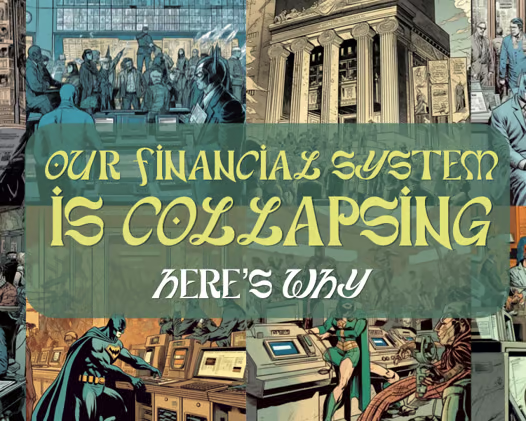The Great Bank Shake-Up: How SVB’s Collapse Exposed the Flaws in the Financial System
Note: I’ve taken a creative liberty with the visuals in this post to make the message more memorable. While I don’t view these individuals as inherently evil, I am convinced that their actions are intentionally stifling crypto and that the shift from the gold standard to fiat marked the start of our financial system’s decline.
It was a hectic morning, and I was already on edge as I hurriedly sipped my matcha.
A notification on my phone sent my pulse racing: “Silicon Valley Bank (SVB) collapses, marking the first FDIC-insured bank failure in two years.”

My gut tightened – I had always been wary of the traditional banking system and had faith in cryptocurrencies, but I never expected to see the system unravel like this.
As I voraciously consumed the news, I felt a growing sense of unease.
SVB, a powerhouse in the tech startup industry and the 16th largest bank in the U.S., had crumbled following a disastrous bond sale.
The Federal Reserve had raised interest rates to combat inflation, leading to higher borrowing costs and a strain on companies, especially venture-backed startups – SVB’s main customers.

Jerome Powell, the financial overlord of the Federal Reserve, manipulates the US economy like a comic book villain. As Chairman, he wields the power of the printing press, dictating monetary policy and juggling interest rates. Tread cautiously, for he holds the fate of the mighty dollar in his hands.
This, in turn, reduced the value of bonds in which banks like SVB had invested their customers’ deposits when rates were lower.
Panic spread like an uncontrollable blaze, leading to a devastating bank run.
The collapse of SVB was now the second-largest bank failure in U.S. history.
Days later, my jaw dropped as I learned that Signature Bank, which served the crypto industry, had also failed.
It was the third-largest bank failure in history.
My disbelief was palpable; the very system that had criticized cryptocurrencies for being unstable was now disintegrating before my eyes.
But as I read further, I discovered a chilling revelation: Signature Bank was targeted by the government and shut down not because it was actually failing, but because it served crypto customers.
This sent a shiver down my spine, as the government’s intentions became clear – they were attempting to control the financial landscape and suppress the rise of cryptocurrencies.
The repercussions of these failures rippled throughout the market, sparking widespread panic and volatility.
Reports of potential failures of other banks only added fuel to the fire.

Believe the government wouldn’t cross the line? Meet Operation Choke Point, a plot straight out of a comic book! In this sinister scheme, the powers-that-be targeted and smothered legitimate businesses by cutting off their lifeline to banks. It’s a chilling reminder that Big Brother’s grip can be tighter than any supervillain’s grasp.
I couldn’t help but feel a strange mix of concern and intrigue, as the world I had known seemed to be collapsing around me.
Throughout March, the U.S. Treasury, the Federal Reserve, and the FDIC raced against time to contain the damage and sell off the troubled banks’ assets.
I closely followed the news, my heart pounding in my chest, unsure of what this would mean for the future of finance.
The investigations into SVB’s collapse by the Department of Justice and the Securities and Exchange Commission peeled back the layers of deception and greed within the system.

Reports of insider stock sales before the bank’s failure only confirmed my long-held suspicions.
The illusion of trust in the traditional financial system was shattering, revealing its flawed foundation.
As a crypto enthusiast, I found myself in a whirlwind of emotions.
While I couldn’t shake the uneasiness that enveloped me, I couldn’t help but feel that this was a turning point in the world of finance.
The downfall of these banks and the government’s deliberate targeting of Signature Bank demonstrated the need for a more decentralized, secure, and transparent financial system – one that wasn’t susceptible to the whims of a few powerful players.
As the government’s intervention eventually stabilized the market, the damage had been done.
The scars left by the banking crisis and the government’s interference served as a stark reminder of the potential dangers lurking in the traditional financial system.

Meet the Crypto Crusaders: visionaries championing a fair, decentralized financial future. Harnessing blockchain and cryptocurrencies, they battle centralized control and stand as beacons of hope in a world of fiscal uncertainty.
For me, and many others in the crypto community, this was a monumental moment – a sign that the age of decentralized finance had arrived.
The world had been shaken, and as the dust settled, I found myself at the forefront of a financial revolution.
There was no turning back now; it was time to forge a new path, and I was ready to embrace the unknown, determined to navigate this new financial landscape with resilience and adaptability.
The future of decentralized finance was uncertain, but I was committed to being a part of its growth and evolution, championing a system that prioritized transparency, security, and independence from centralized control.
The Inherent Flaws of Fiat: Understanding the Appeal of Cryptocurrency
Crypto and blockchain are totally here to stay, and they’re definitely not just some passing fad.
Let’s break it down real quick.
You’ve got your old-school money, like dollars, right?
That’s called fiat currency.

Introducing the sinister Fiat Currency, a malevolent force haunting the global economy! It manipulates value and breeds inflation, mercilessly devouring citizens’ hard-earned wealth.
Just like the car.
Fiat currency, like the US dollar or the Euro, is a type of money that isn’t backed by a physical commodity, such as gold.
Instead, its value comes from the “good faith” and trust people have in the government that issues it.
Essentially, we believe it has value because the government says it does and everyone agrees to use it for trade.
It wasn’t always this way, though. Before 1971, the US dollar and some other currencies were backed by gold.

Meet Richard Nixon, the mastermind who altered the course of our financial destiny. By severing the tie between gold and the dollar, he unleashed the fiat system’s Pandora’s Box. This pivotal move marked the beginning of the end for our once-stable financial system, leaving us to navigate a world of uncharted monetary chaos.
This meant that you could exchange your paper money for a certain amount of gold, giving it a solid and tangible value.
However, in 1971, President Nixon decided to eliminate the gold standard, making the US dollar a purely fiat currency.
Since then, fiat currencies have relied solely on the trust people have in the government and the stability of the economy.
This shift has made some people wary of fiat money and has been one of the factors that sparked interest in alternative forms of currency, such as cryptocurrencies like Bitcoin, which offer a different approach to storing and exchanging value.
But the thing about fiat is, the government can just print more and more of it, and we all know what happens when they do that: inflation.
I know we’ve all seen the meme; The USD printer’s been going “brrrr” like crazy, and that’s a problem.
We’re all feeling the effects of that now each time we visit the grocery store.

Now, let’s talk about the new kid on the block: cryptocurrency.
Take Bitcoin, for example.
It’s designed with a limited supply, which means no one can go wild and just make more of it.
That makes it way better at resisting inflation.
The Bitcoin printer just can’t go “brrrr,” and that’s awesome.
The reason Bitcoin is such a game-changer is that it’s decentralized.
To help you understand what that means, let’s use an analogy.
Imagine you’re a kid again, and you and your friends want to play a game during recess.
Usually, there’s a teacher or a playground leader who makes all the rules and decisions for everyone.

Meet the sly Gary Gensler, a financial supervillain atop the SEC! With his regulatory powers, he targets the crypto world, seeking to dominate digital assets. Beware his relentless pursuit, for he’ll subdue innovation and freedom!
But let’s be honest, no one really likes that.
The teacher is often out of touch and creates rules that make her life easier instead of focusing on what the students want, which is to have the most fun possible.
Now picture a different game, one where instead of having one person in charge, all of you together decide on the rules and how the game should be played.
This way, everyone gets a say, and no single person controls the entire game. That’s what decentralization is all about.
It means that rather than having one big boss or a single company controlling everything, the power and decision-making are distributed among many people.
In the world of money and technology, like with Bitcoin, decentralization ensures that everyone who uses it has a say in how it works, making it fairer and more democratic for everyone involved.
This revolutionary idea came from a super-smart person (or group of people) called Satoshi Nakamoto, who invented Bitcoin in response to the 2008 financial crisis.

Meet Satoshi Nakamoto: the cryptic genius behind Bitcoin! This faceless hero’s true identity remains a mystery, yet their revolutionary creation sends shockwaves through the financial world, igniting the quest for financial freedom. A cryptographic prodigy!
They wanted to create a whole new kind of money that wouldn’t be plagued by the same problems that caused the crisis in the first place.
And with Bitcoin’s decentralized nature, they managed to do just that, offering a more resilient and fair financial system for all.
CBDCs: A New Challenge for Privacy, Autonomy, and Decentralization
It’s important to recognize that the rise of crypto has not gone unnoticed by governments, who see the value in blockchain technology and are trying to implement their own Central Bank Digital Currencies (CBDCs).
However, this development seems to be drifting away from Satoshi Nakamoto’s original vision of Bitcoin and decentralized finance.
CBDCs represent a potential threat to the crypto landscape, as they could ultimately undermine the very principles of decentralization, privacy, and financial autonomy that cryptocurrencies like Bitcoin were built upon.

Beware the sinister rise of Central Bank Digital Currencies (CBDCs)! These malevolent tools enable governments to pry into the lives of unsuspecting citizens, invading their financial privacy like a dark and omnipresent shadow.Instead of empowering individuals, CBDCs may further tighten the grip of governments and central banks on our financial lives, leading to a dystopian future where every transaction is monitored and controlled.
That being said, it’s crucial for people across the political spectrum to unite against the negative implications of CBDCs, as preserving financial freedom and privacy is a shared concern.
By rallying around the true spirit of cryptocurrencies and decentralization, we can raise awareness of the potential dangers of CBDCs and emphasize the importance of maintaining the original intentions behind blockchain technology.
In conclusion, while governments may see the value in crypto and attempt to harness it through the creation of CBDCs, it’s essential for us to remain vigilant and vocal in our opposition to any developments that threaten the core principles of decentralization, privacy, and financial freedom.
By standing together, we can ensure that the liberating power of decentralized finance remains a driving force in the global economy.
Taking Control of Our Financial Destiny: Cryptocurrencies as the New Normal
Personally, I have made the conscious decision to stop holding US Dollars and transition entirely to Bitcoin and tokenized dollars like USDC.
This choice stems from the widespread loss of faith in government institutions, which increasingly seem to no longer have our best interests at heart.
As a result, it has become essential for us to take control of our financial destiny and seek out alternatives that offer greater stability and autonomy.
The erosion of trust in governments and their ability to manage fiat currencies has only exacerbated the need to find a more secure and reliable form of storing and exchanging value.
Bitcoin and other cryptocurrencies have emerged as viable alternatives, providing a hedge against the devaluation of traditional currencies while also promoting decentralization and financial freedom.
By embracing Bitcoin and tokenized dollars like USDC, I am taking a stand against the potential pitfalls of relying solely on government-issued currency.

I wholeheartedly believe that cryptocurrencies are the answer to the challenges we face in today’s financial landscape, offering a more transparent, secure, and egalitarian system that empowers individuals to take control of their financial futures.
In conclusion, as faith in government institutions continues to wane, it is incumbent upon us to seek out alternatives that safeguard our financial well-being.
By choosing to hold Bitcoin and other cryptocurrencies, I am actively participating in the burgeoning world of decentralized finance, which I believe holds the key to a more resilient, equitable, and prosperous future for all.
Stay curious,
Addie LaMarr



